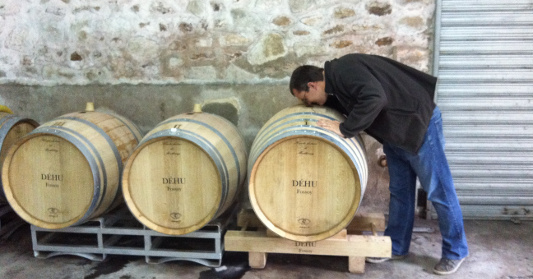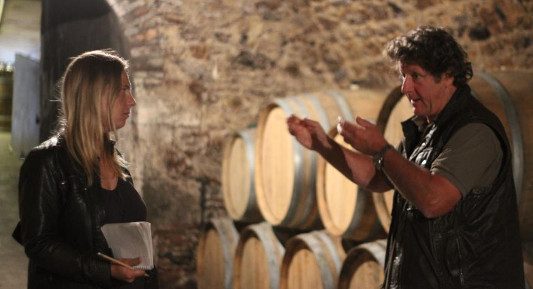|
|
Terroir Champagne – Fact or Fiction
Caroline Henry for 1000 Corks
The word "terroir" has been creating waves in the wine wine world for the last few decades. While it was traditionally more associated with the old wine world, Europe, winemakers all over the world have been jumping on the bandwagon.
Even in Europe, some regions which originally were not very much terroir focused have been drawn to the concept. Why is this? I believe it is the perfect term to use when one is trying to distinguish oneself from others; it is also a term consumers have started to understand and look for when they want something more unique.

The original terroirists are the Burgundians – whose appellation system is completely terroir based, and who more recently are awaiting Unesco Heritage Protection for their Climats – the name they use to describe their terroirs.
Just north of Burgundy, the Champenois also applied for Unesco Protection for their terroir, even though the the notion of terroir is a lot less intrinsic in Champagne than it is in Burgundy.
So can we speak about Terroir in Champagne – and if yes till what extent?
There definitely exists a notion of terroir in Champagne, but this is in a more generic sense; it includes among other things the chalk subsoil, the continental climate, and the vineyard slopes.
But even if it is generally accepted that unique regional terroir is what made Champagne so famous, there is a general reluctance to talk about terroir on a more local or micro level. This is because the focus has always been on the blend and the savoir faire of the chef de cave.
Even the Grand Cru system is based on a village rather than vineyard/lieu dit level. This is because the average size of a champagne vineyard plot is 0,012 hectares. Yet it is also known that some vineyards or lie dits are more special than others, and the wines coming from these places are very expressive and unique.
One of the most famous examples, as well as being the first example of a single vineyard Champagne, is Philipponnat’s Clos des Goisses, which was first made in 1935.
It is a very steeply sloped south facing vineyard next to the canal in Mareuil-sur-Ay. The exposure alone makes it probably the most sun drenched place of the region, and it is one of the reasons Phillipponnat can make a single vineyard vintage Champagne year after year. This Champagne is also one of the most sought after by connoisseurs.

But does one have to choose between terroir and blend?
In fact no – the Clos des Goisses is a blend of two grape varieties, and several barrels, even if the origin is one actual place in one particular year.
Another expression of terroir champagne is a blend of several vintages of the same vineyard or lieu dits together. This will give the expression of a place over several years - the most famous examples here are probably the lieu dits by Anselme Selosse.
And of course there are Terroir Champagnes which are the expression of a vineyard, across different varieties and different years – like the Cuvee Louis by Champagne Tarlant for instance.
But blended or not, the general rule of thumb is that there are very few bottles of Terroir Champagne made. The first reason, which we already mentioned, is that the lieu dits or vineyards are quite small, which restricts the quantity.
The second and more important reason is that in order to make Terroir Champagne the soil in the vineyard needs to be alive. It is very difficult to give a unique expression of a polluted, dead place. While this may seem obvious, it is unfortunately quite exceptional in Champagne.
In the words of Isabelle Legeron, MW, "the region is one of the most polluted wine regions in the world". Since the business of Champagne is more focused on quantity than quality there also are very few incentives to farm more environmentally friendly. In general this way of farming means lower yields for more work.
And we have to remember that the bulk of the grapes are farmed by grape growers who are paid by the kilo and sell their crops to the Champagne Houses; they in turn will make quite standardized high volume Champagne out of them. Right here is yet another reason why there is so little focus on terroir Champagnes.
To recapitulate, Terroir Champagne does exist. In fact it is actually quite sought after, especially by more enlightened sommeliers, wine store owners and wine lovers with a preference for more natural wine.
And the fact that there is very little of it made adds to its desirability. That is why this type of Champagne is in fact the real luxury coming out of the region.
Let me elaborate – currently there are barely seventy certified organic producers, yet the region counts more than 15,000 winegrowers. Together with a few other producers who work in a real sustainable way, the total production of Terroir Champagne is somewhere between seven and ten million bottles a year, which is a fraction of Champagne’s total production of around 345 million bottles a year.
We can surmise that the total production of Terroir Champagne (when all producers are added) could be around the same as the total production of the prestige cuvee Dom Perignon. The biggest difference between the two remains the way the vineyard is farmed.
If we were to put this in regular or still wine terms one could argue that Terroir Champagne is the equivalent of natural wine – both are just as dividing, with people either passionately loving or hating them. But as with natural wine, more and more people are drawn to them.
About Caroline
Caroline Henry is the only English speaking journalist and wine writer based in Champagne. She regularly contributes to wine-searcher.com, Decanter, Palate Press and Snooth.
Over the last three years she has been specializing in the wines of Champagne. She teaches on the subject of sparkling wine in several wine programs in France and abroad and is also part of the research team of the Pole Champagne at the Reims Management School.
Caroline is a sommelier certified by the Court of Sommeliers in London as well as a wine location specialist on Champagne. Natural, organic and biodynamic wines are her great passions besides Champagne. She aims to publish the first book on environmentally friendly produced Champagne in September 2015.
To find out more about her book project please visit IndieGogo.
Six comments
Caroline,
Actually, I think it would be more correct to say that the whole of the French appellation system is based on a concept of "terroir". Not just Burgundy.
On the other hand you seem to use the word "terroir" in the more restrictive sense of meaning simply "soil".
(BTW I think Agence Bio gives the number of more than 90 of certified organic today in Champagne Ardennes. Happened to see the number yesterday.)
Thank you for your comment Per. Off course I see Terroir much wider than just the soil - there is the microclimate, exposure, slope and I even add the person planting and tending to the vines - which I know is very contested.
I don't particularly believe that the whole of France's AOC system is based on terroir the way it is for the Burgundians - as far as I know there is no other region which based their Grand Cru system on vineyard level.. (Bordeaux is Chateau, Alsace is Lieu dit or village and Champagne is village).
Re number of certified vignerons, I got my figures from Vincent Laval the president of the AIVABC - the official viticultural organisation in Champagne. It does not include the people in conversion. However, if you take a look at the data Agence Bio gives for Champagne Ardennes and you look for Vigne - you see a decline of 7% in 2013 (After the difficult vintage of 2012). You can see there are 374 HA certified and in conversion (of the almost 34, 000 HA planted) which is 0,011%... Here is the link to the information http://www.agencebio.org/sites/default/files/upload/documents/4_Chiffres/BrochureCC/Regions/CC_fiche_CA.pdf I am not sure where you got the 90 producers from...
The number is actually given as 94 in Champagne Ardennes here: http://www.agencebio.org/les-filieres-bio but it is not clear (to me) if that is for the 258 ha certified or if it is for the 374 ha certified+in conversion.
If you look at "terroir" as including things like climate, viticultural practices, traditions, etc then I'd say that the entire French AOC system is underpinned by the concept of terroir. The AOCs codify much of that in the AOC rules.
What the Burgundians have done is fragmented it down to a microscopic level (well, vineyard level) which really has more to do with soil (and to some extent possibly tiny differences in micro climate, but that is often doubtful) than with anything else. There's not much difference in viticultural practices, traditions, or human intervention from one grand cru to another in Burgundy.
Hi Per,
thank you for commenting again. As you can see from the figures provided there is a steep decline in organic growers in 2013 compared to 2012. I need to check with Vincent for exact details and numbers but I know some people have split up their companies into RM and grape suppliers - which means they sometimes count twice in the figures. Examples are anyone who sells organic grapes to the likes of Leclerc Briant, Chateau d'Avize, Marguet, Canard Duchene or Duval Leroy to name but a few. Even though especially the last two buy from growers who only grow organic grapes to sell by the kilo, most others by from people who make their own Champagne and sell a little surplus (eg Léclapart, Horiot). To do this most of them set up a second business; so even if they are the same people they are counted twice... Also you will see that the Agence Bio gives te figures for table grapes and wine grapes together. I know quite a few local producers of table grapes - sold as organic on the market - which means they are included in the figures of Agence Bio but not in the AIVABC figures. As the latter is the official instance dedicated solemnly to viticulture I have based my figures on the one supplied by them
If we were to put this in regular or still wine terms one could argue that Terroir Champagne is the equivalent of natural wine – both are just as dividing, with people either passionately loving or hating them. But as with natural wine, more and more people are drawn to them.
Caro, Not sure I agree with you that Terroir Champagne is same as Natural wine . Natural wines are organic and you can make Terroir wines without being organic . Also Natural wines don't include sulphur etc but these additions don't preclude a champagne being a Terroir Champagne in my eyes. Ciao Ian
Thank you, terroir characteristics include natural. I support the context of the use of natural in this writing to position the terroir of champagne showing itself in more natural producers than conventional.